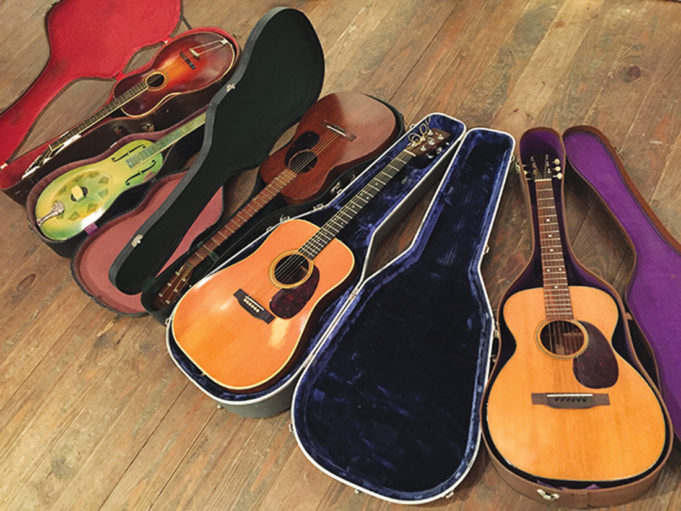The annual Fort Worth Show of Antiques & Art has been offering everything from old toasters to Victorian furniture to porcelain figures to original paintings for more than 50 years at the Will Rogers Memorial Center.
“Ten cities in the whole world have antique shows that have been going on for 53 years,” said show director Jan Orr-Harter. “The Fort Worth show has been able to reinvent itself again and again.”
Its latest reinvention begins this year. Orr-Harter invited dealer Emil Knodell, 68, who lives outside of Austin, to bring his enticing collection of vintage guitars. Knodell is a longtime amateur guitarist who has collected an impressive bunch of vintage acoustic guitars ranging from the 1920s to 1960s.
“Most prestigious shows wouldn’t let someone like that in, but we like fresh, we like things with a creative cutting edge, and that’s one reason this antique show has flourished for so long,” Orr-Harter said. “Antiques aren’t a static thing. It changes.”
Orr-Harter has been trying for several years to attract a vintage guitar dealer to the show. Knodell is the first to take the bait, and this will be his first time to lease space at the show, she said.
“The music profile in Fort Worth is going up, and people are seeing Fort Worth as more of a music town, so [Knodell] is willing to come,” she said. “The audience is getting younger at this show, and we’re trying to find merchandise that appeals to people in the 20s, 30s and 40s. There is a lot of interest in music in those age groups.”
Knodell is a traditional antique dealer, but his personal interest in music prompted him to start collecting vintage guitars in the 1970s. Typically, he bought instruments that sounded and played well because he used them for home recording projects.
He expects to bring a dozen or more guitars to the Fort Worth show representing every decade between the 1920s and 1980s. One of his oldest models is a 1928 Gibson L-4. He’s also bringing an assortment of Martin guitars, including ones from 1945 and 1957 made with mahogany, and a 1965 D-28 made with the coveted Brazilian rosewood back and sides. Guitar makers relied on Brazilian rosewood back in the old days before supplies grew thin and people began worrying about destroying forests. Most guitar makers switched to Indian rosewood in the 1970s, making collectors savor the earlier instruments with the more desirable wood.
Indian and Brazilian rosewood create similar tones in guitars, Knodell said, although the Brazilian version is considered more appealing to collectors both aesthetically and audibly.
“You don’t get the beautiful patterning in the wood like you do with Brazilian,” Knodell said. “It’s lovely to look at and great sounding. That wood is older and cured more, and many people consider that it sounds better.”
Taking care of vintage guitars can include establishing humidity and temperature controls to avoid warping and to preserve tonal qualities. Maintaining and insuring a large collection is a labor of love and a responsibility. Knodell’s ready to thin his herd and let others take on some of that liability.
“At this point in my life, it’s time to yield to someone else,” he said. “I’ve loved them. I’ve used them all. I’ve recorded with all of them. They’re great guitars. Each is an individual with its own personality and voice, and all are playable instruments that have been properly cared for.”
For the past couple of decades, Japanese dealers have been visiting American guitar shows, buying vintage instruments, and shipping them back to their homeland for sale. The Japanese people tend to crush on vintage guitars that hark back to the earliest days of rock ’n’ roll and pop music. The advent of online auction sites also made vintage guitars a hot commodity. Knodell compiled his instruments back when people perused pawnshops, garage sales, and flea markets to find vintage guitars.
“Because of the internet, it is a worldwide phenomenon,” he said. “That has greatly expanded their desirability and, as a result, has elevated their prices.”
Whether antique shoppers will view an old guitar as a collectible investment rather than a utilitarian tool remains to be seen. Knodell bought them because he played them. Will non-players be interested?
“There is a certain appeal about guitars,” he said. “Even people who don’t play guitars appreciate them for their beauty and their historical value. The instruments I have, I have always gotten them with playability in mind. It just so happens that some of them are in exceptionally great condition.”
Guitars have enjoyed a rabid collector base for decades. The interest has been so strong for so long, plenty of research materials are available. Maker’s marks and serial numbers make it fairly easy to find out about an instrument’s history. Prices have tended to go up over the years without crashing back down.
Knodell has sold a few random guitars at antiques shows in the past but never tried to sell this many at once. He’ll find out whether the antique crowd embraces them.
“Generally, a musician looking for a guitar won’t go to an antique show or an antique store to find a guitar,” Knodell said. “I have sold guitars at antique venues because the mentality is the same. People have an appreciation for beauty, craftsmanship, and quality materials. Guitars exhibit all of those characteristics. Many are used for decorative purposes. Many are unplayable. Many are curiosities. The instruments I’m bringing have the beauty and appeal but are also totally playable. They’re good solid instruments for investment.”
Scott Dyson, owner of Competition Music, has hosted the Fort Worth Guitar Show for 15 years and sold thousands of guitars in his day. He can envision a vintage guitar fitting into antique shows due to its age and desirability, but he can’t see a non-player ponying up much money for a wall hanger.
“Most people who buy vintage guitars have some knowledge of the instrument and how to play it, unless they’re rich and just like buying things,” he said. “The vast majority of the people who buy guitars play guitar. I have no facts to back this up, but I’d say less than 5 percent of people who buy a guitar buy it to hang it on a wall and not play it.”












